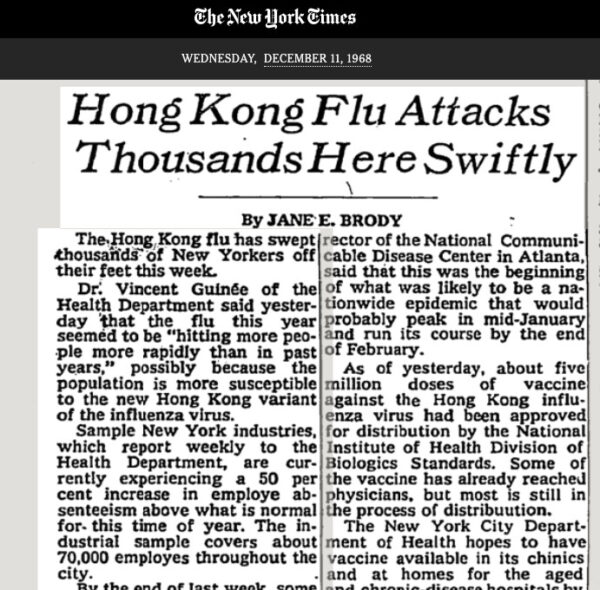The following article was copied and pasted from my electronic subscription of Epoch Times.
To subscribe at $1 for two months and $9.99 per month thereafter, use the following link:
https://subscribe.theepochtimes.com/p/?page=digitalsub
I nearly died from the Hong Kong Flu in 1968, so I read this article; he makes some valid comparisons between our nation’s response in 1968 and 2020.
Begin ET Article:
The 1968-69 ‘Hong Kong Flu’ Pandemic Revisited
It was a very bad year for the flu. The pathogen came in two large waves. This is only obvious in retrospect. At the time, not so much. Life went on as normal. There were gatherings. There were parties. There was travel. There were no masks. Doctors treated the sick. Traditional public health reigned as it had during the flu pandemic ten years earlier. No one considered lockdowns.
It’s a good thing because it was in the thick of this that many “super-spreader” events took place, among which was Woodstock itself. That event influenced all popular music after and continues to do so today. No one was denied schooling or worship or separated from loved ones while they were dying. Weddings took place as normal. Indeed, hardly anyone remembers any of this.
This flu strain (H3N2) spread from Hong Kong to the United States according to the predictable timetable, arriving December 1968 and peaking a year later. It ultimately killed 100,000 people in the U.S., mostly over the age of 65, and one million worldwide.
Lifespan in the United States in those days was 70 whereas it is 78 today. Population was 200 million as compared with 328 million today. If it would be possible to extrapolate the death data based on population and demographics, we might be looking at a quarter million deaths today from this virus. (As for precisely how many died from COVID, we are not really in a position to know yet due to confusion between cases and inflection, forced mass testing, inaccurate testing, and widely admitted cause-of-death misclassification.)
So in terms of lethality, it was deadly and scary. “In 1968/69,” says Nathaniel L. Moir in National Interest, “the H3N2 pandemic killed more individuals in the U.S. than the combined total number of American fatalities during both the Vietnam and Korean Wars.” It was not as grim as 1957–58 but it still carried a 0.5 percent case fatality rate.
And this happened in the lifetimes of every American over 54 years of age.
You could go to the movies. You could go to bars and restaurants. John Fund has a friend who reports having attended a Grateful Dead concert. In fact, people have no memory or awareness that the famous Woodstock concert of August 1969—planned in January during the worst period of death—occurred during a deadly American flu pandemic that only peaked globally six months later. There was no thought given to the virus which, like ours today, was dangerous mainly for a non-concert-going demographic.
Stock markets didn’t crash because of the flu. Congress passed no legislation. The Federal Reserve did nothing. Not a single governor acted to enforce social distancing, curve flattening (even though hundreds of thousands of people were hospitalized), or banning of crowds. The only school closures were due to absenteeism.
No mothers were arrested for taking their kids to other homes. No surfers were arrested. No daycares were shut even though there were more infant deaths with this virus than the one we just experienced. There were no suicides, no unemployment, no drug overdoses attributable to flu.
Media covered the pandemic but it never became a big issue.
The only actions governments took was to collect data, watch and wait, encourage testing and vaccines, and so on. The medical community took the primary responsibility for disease mitigation, as one might expect. It was widely assumed that epidemics require medical not political responses.
It’s not as if we had governments unwilling to intervene in other matters. We had the Vietnam War, social welfare, public housing, urban renewal, and the rise of Medicare and Medicaid. We had a president swearing to cure all poverty, illiteracy, and disease. Government was as intrusive as it had ever been in history. But for some reason, there was no thought given to shutdowns.
Which raises the question: why was this time different? We will be trying to figure this one out for decades. Was the difference that we have mass media invading our lives with endless notifications blowing up in our pockets? Was there some change in philosophy such that we now think politics is responsible for all existing aspects of life?
Was there a political element here in that the media blew this wildly out of proportion as revenge against Trump and his deplorables? Or did our excessive adoration of predictive modeling get out of control to the point that we let a physicist with ridiculous models frighten the world’s governments into violating the human rights of billions of people?
Maybe all of these were factors. Or maybe there is something darker and nefarious at work, as the conspiracy theorists would have it. Regardless, they all have some explaining to do.
By way of personal recollection, my own mother and father were part of a generation that believed they had developed sophisticated views of viruses. They understood that less vulnerable people getting them not only strengthened immune systems but contributed to disease mitigation by reaching “herd immunity.” They had a whole protocol to make a child feel better about being sick. I got a “sick toy,” unlimited ice cream, Vicks rub on my chest, a humidifier in my room, and so on.
They would constantly congratulate me on building immunity. They did their very best to be happy about my viruses, while doing their best to get me through them.
What happened between then and now? Was there some kind of lost knowledge, as happened with scurvy, when we once had sophistication and then the knowledge was lost and had to be re-found? For COVID-19, we reverted to medieval-style understandings and policies, even in the 21st century, and at the urging of the media and myopic advice from governments. It’s all very strange. And it cries out for answers.
From the Brownstone Institute
Views expressed in this article are the opinions of the author and do not necessarily reflect the views of The Epoch Times.




